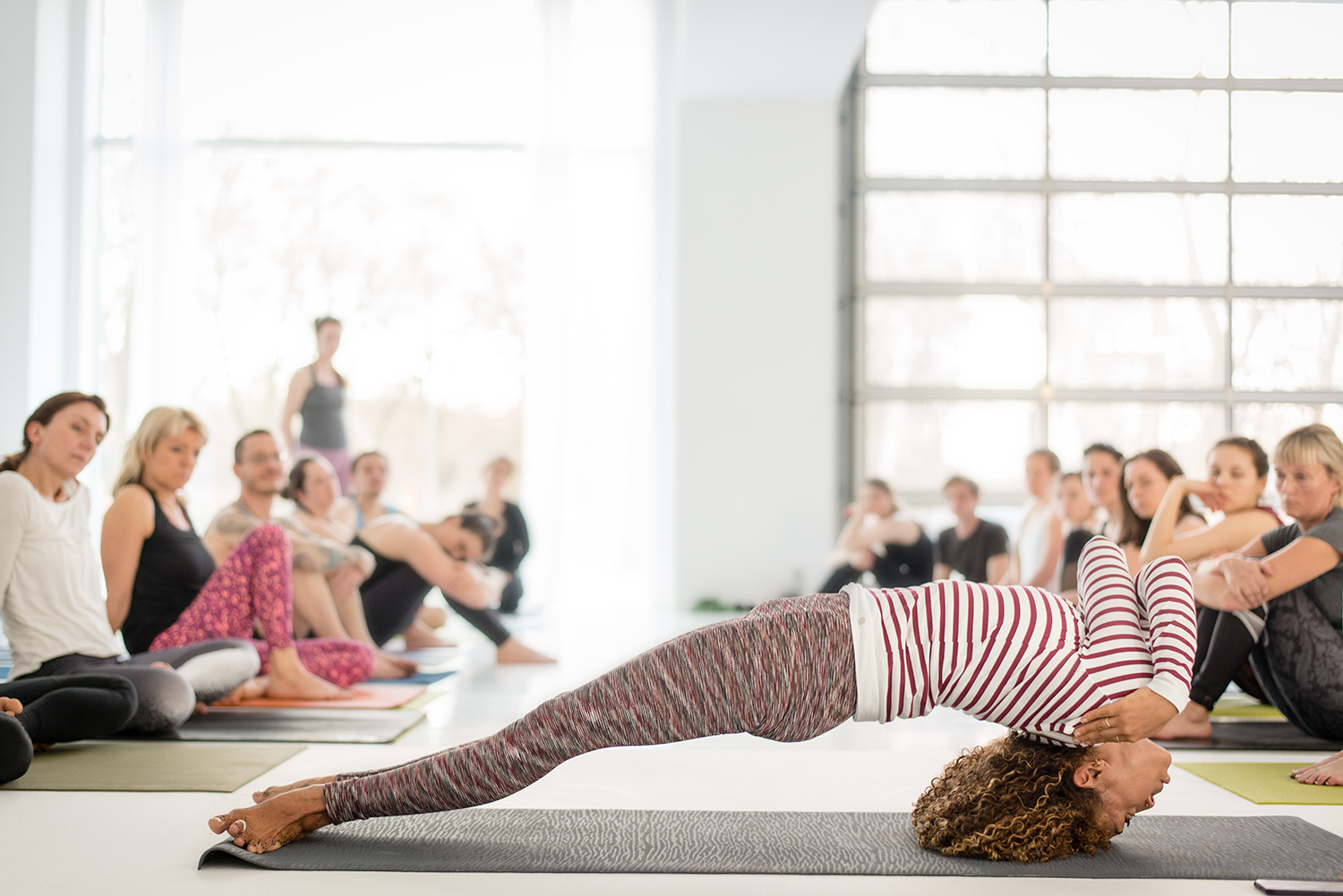....
Der Workshop mit Laruga Glaser liegt bereits einige Zeit zurück, aber wir möchten uns noch einmal ganz herzlich bei Laruga für die Zeit bei uns bedanken. Wir haben auch eine Auswahl von Bildern zusammengestellt. Für die von euch die Ashtanga Yoga nicht kennen, hier erst einmal eine kurze Beschreibung:
Ashtanga Yoga heißt übersetzt das achtzweigige Yoga, wovon die Asanas, die Körperübungen einen Zweig darstellen. Mehr über die anderen sieben Zweige könnt ihr hier nachlesen.
Praktiziert werden verschiedene, im Schwierigkeitsgrad ansteigende Serien, die in fest aufeinander abfolgender Posen aufgebaut sind.
Bevor man praktiziert chantet man das Eröffnungsmantra. Schon hier spürt man die Intensität der Praxis. Wir haben das Eröffnungsmantra beim Workshop aufgenommen. Herzlichen Dank an Laruga, dass wir den Audio File hier verwenden dürfen!
..
The workshop with Laruga Glaser happened a while ago, but we would like to thank Laruga again for the time with us. We have also compiled a selection of pictures. For those of you who do not know the Ashtanga Yoga, here is a brief description.
Ashtanga Yoga is the translation of the eighth-century yoga, of which the asanas, the physical exercises, represent a branch. You can read more about the other seven branches here.
A series of successive serieses, of fixed poses, are practiced.
Before practicing youchant the opening mantra. Even here you can feel the intensity of the practice. We recorded it at the workshop. Thanks to Laruga for allowing us to use the audio files here!
....
OM
Vande Gurunam Caranaravinde Sandarsita Svatma Sukhava Bodhe Nih Sreyase Jangalikayamane Samsara Halahala Mohasantyai Abahu Purusakaram Sankhacakrasi Dharinam
Sahasra Sirasam Svetam Pranamami Patanjalim
OM
Der erste Teil des Mantras bezieht sich auf die Yogapraxis.
Vande Gurunam charanaravinde "Ich bete zu den Lotusfüßen des höchsten Gurus" - Guru = Lehrmeister, Führer. Die Yogasutras des Pantanjali können als höchsten Guru angesehen werden oder die Yogapraxis selbst. Wir erklären uns bereit, uns der Ausführung der Yogapraxis hinzugeben und vertrauen darauf, dass es uns in eine wohltuende Richtung führt und uns das Wissen (bodhe) von der Glückseligkeit (sukha) unseres Selbst (svatma) enthüllt. Ohne Vergleich (nishreyase), ist "er" jemand der heilt, ein Schamane (jangalikayamane), der uns befreit von dem Gift (hâlâhala) der Konditionierungen (samsara), durch friedvolle (shantyai) Überwindung der Irreführung und Täuschung (moha).
Der zweite Teil des Mantras richtet sich an Patanjali. Seine Verehrung findet in mythologischen Bildern seinen Ausdruck. Er wird dargestellt als die göttliche Schlange Ananta, mit tausend (sahasra) Köpfen (shirasam), weiß leuchtend, strahlend (svetam). Unterhalb seiner Schultern (abahu), in menschlicher Gestalt (purushakaram) hält er (dharinam) ein Muschelhorn (shanka), ein brennendes Rad oder Diskus (chakra) und ein Schwert (asi). Das Muschelhorn wird oft bei festlichen religiösen Anlässen geblasen und symbolisiert den alles durchdringenden göttlichen Schall, das brennende Rad oder die Scheibe aus Licht versinnbildlicht Unendlichkeit , das Schwert symbolisiert Erkenntnis oder Scharfsinnigkeit. Pranamami Patanjalim, ich wende mich an Patanjali - vor ihm verbeuge ich mich. Om
aum Urklang, Symbol des höchsten Göttlichen (Hauptwort) Amen (Adverb)
..
OM
Vande Gurunam Caranaravinde Sandarsita Svatma Sukhava Bodhe Nih Sreyase Jangalikayamane Samsara Halahala Mohasantyai Abahu Purusakaram Sankhacakrasi Dharinam
Sahasra Sirasam Svetam Pranamami Patanjalim
OM
The opening chant of Ashtanga is translated on the Ashtanga Yoga Research Institute website as:
I bow to the lotus feet of the Gurus,
The awakening happiness of one’s own Self revealed, Beyond better, acting like the jungle physician, Pacifying delusion, the poison of Samsara.
Taking the form of a man to the shoulders,
Holding a conch, a discus, and a sword,
One thousand heads, white,
To Patanjali, I salute.
The two verses of the chant come from different sources. The first verse is part of a longer poem called the Yoga Taravalli written by Adi Sankara, and is said to be one of Krishnamacharya’s favorites.
The second verse is part of the Patanjali Invocation, which is often chanted before chanting the Yoga Sutras. According to Geeta Ivengar:
‘The authors of [this] invocation are actually unknown….However, some traditional books mention that abahu purusakaram was written by King Bhojadeva in 1, 100 AD, author of Rajamartanda Vrtti a commentary on the Yoga Sutras.
....
....
Das Mantra war an allen drei Tagen die Einleitung, danach hat uns Laruga durch die Erste Serie, am dritten Tag durch Teile der Zweiten Serie geführt.
..
The Mantra was the initiation on all three days, afterwards Laruga led us through the First Series, on the third day through parts of the Second Series.
....
....
Bilder vom Workshop:
..
Images of the workshop:
....
....
Abgeschlossen haben wir unsere Tage immer mit dem Closing Mantra. Man bitte darum, dass die Mächtigen der Welt weise Entscheidungen treffen und dass die Menschen glücklich und zufrieden leben können.
..
We ended our days with the closing mantra. We asked for the people in power to make wise decisions and that all people can live happily and peacefully.
....
....
OM
Swasthi prajabhyah
paripalayantam
Nyayena margena mahi mahishaha
Gobrahmanebhyaha
shubhamastu nityam
Lokaasamastha sukhino bhavanthu
OM shanti shanti shanti
Das Mangala Mantra (mangala = segensreich, glücklich) ist ein uraltes Mantra aus den Veden. Mit diesem Mantra senden wir Liebe, Licht und Frieden in die Welt.
Möge das Wohlergehen der Menschheit geschützt sein,
Möge der Herrscher der Erde über den Pfad der Tugend schreiten.
Möge das Göttliche und die Gelehrten gesegnet sein. Mögen die drei Welten voll Glück und Wohlergehen sein.
..
OM
Swasthi prajabhyah
paripalayantam
Nyayena margena mahi mahishaha
Gobrahmanebhyaha
shubhamastu nityam
Lokaasamastha sukhino bhavanthu
OM shanti shanti shanti
May all be well with mankind
May the leaders of the earth protect in every way by keeping to the right path
May there be goodness for those who know the earth to be sacred
May all the worlds be happy
There is also an extra verse
Kale varsatu parjanyah prthivi sasyasalini
Desoyam ksobharahito brahmana santu nibhayah
May the rains fall on time, and may the earth yield its produce in abundance. May this country be free from disturbances,
and may the knowers of the truth be free from fear.
....
....
Vielen Dank an Laura und alle Teilnehmer für diese super inspirierende Wochenende! Mehr über Laruge findet ihr auf ihrer Webseite: http://larugayoga.com
..
Many thanks to Laruga for this truly inspiring weekend! You can find more about her at http://larugayoga.com.
....





































